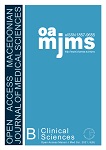Experiences of Renal Stone Fragmentation with the Use of the Ultrasound-guided Mini-percutaneous Nephrolithotipsy in 650 Patients
DOI:
https://doi.org/10.3889/oamjms.2021.5387Keywords:
Renal stone, Mini-percutaneous nephrolithotipsy, Ultrasound-guidedAbstract
AIM: This study assesses the results of treatment using the mini-percutaneous nephrolithotipsy (PCNL) procedure on renal stone patients in a lateral position under ultrasound guidance, performed at the Ha Noi Hospital of Post and Telecommunications.
METHODS: The study was conducted with 650 kidney stone patients who were treated using the ultrasound-guided mini-PCNL procedure in a lateral position, at the Ha Noi Hospital of Post and Telecommunications, over the period from June 2018 to June 2019.
RESULTS: For the 650 patients, the mean age was 47.3 ± 7.6 (from 21 to 91 years old); the mean size of stones: 19.4 ± 1.2 mm (from 12 mm to 60 mm); the mean operative time: 49.3 minutes (from 37 to 90 min); the mean period of hospitalization: 3.9 days (from 3 to 12 days); the mean stone-free rate (SFR): 90.6%; the rate of second surgery: 1.07%; hemorrhage complication: 0.8%; urinary tract infections: 7.7%; septicemia: 0.6%; administered open surgery: 0.46%; and administered other methods: 0.76%.
CONCLUSION: Renal stone fragmentation using the mini-PCNL procedure, performed on patients placed in lateral position under ultrasound guidance, is a method that is effective, beneficial, and safe for patients with renal stones and upper ureteral stones.
Downloads
Metrics
Plum Analytics Artifact Widget Block
References
Fernstrom I, Johansson B. Percutaneous pyelolithotomy. A new extraction technique. Scand J Urol Nephrol 1976;10(3):257-9. PMid:1006190
Helal M, Black T, Lockhart J, Figueroa TE. The Hickman peel-away sheath: alternative for pediatric percutaneous nephrolithotomy. J Endourol 1997;11(3):171-2. https://doi.org/10.1089/end.1997.11.171 PMid:9181444
Abdelhafez MF, Bedke J, Amend B, ElGanainy E, Aboulella H, Elakkad M, et al. Minimally invasive percutaneous nephrolitholapaxy (PCNL) as an effective and safe procedure for large renal stones. BJU Int 2012;110(11 Pt C):E1022-6. https://doi.org/10.1111/j.1464-410x.2012.11191.x PMid:22540846
Zeng G, Zhao Z, Wan S, Mai Z, Wu W, Zhong W, et al. Minimally invasive percutaneous nephrolithotomy for simple and complex renal caliceal stones: A comparative analysis of more than 10,000 cases. J Endourol 2013;27(10):1203-8. https://doi.org/10.1089/end.2013.0061 PMid:23924320
Hennessey DB, Kinnear NK, Troy A, Angus D, Bolton DM, Webb DR. Mini PCNL for renal calculi: does size matter? BJU Int 2017;119 Suppl 5:39-46. https://doi.org/10.1111/bju.13839 PMid:28544299
Thanh DT, Dang LH, Hoang NH. Ultrasound guided access during percutaneous Nephrolithotomy on patients in lateral position assessment of Outcome in 250 cases traited at the viet-germany friendship Hospital, Vietnam. Int Braz J Urol 2018;7(1):22-30. PMid:27583353
Turk C, Petrik A, Sarica K, Seitz C, Skolarikos A, Straub M, et al. EAU guidelines on interventional treatment for urolithiasis. Eur Urol 2016;69(3):475-82. https://doi.org/10.1016/j.eururo.2015.11.009 PMid:26344917
Zimmermanns, V., S. Kurzidim, P. Liske, S.Lahme. Minimal invasive PCNL (MPCNL) proven efficiency and safety after more than 650 consecutive patients. Eur Urol Suppl 2012;11(1):e1032. https://doi.org/10.1016/s1569-9056(12)61028-8
Zare S. Feasibility of pure ultrasonography guided percutaneous nephrolithotomy in flank position. Nephro Urol Mon 2017;9:e47051. https://doi.org/10.5812/numonthly.47051
Basiri A, Ziaee AM, Kianian HR, Mehrabi S, Karami H, Moghaddam SM. Ultrasonographic versus fluoroscopic access for percutaneous nephrolithotomy: A randomized clinical trial. J Endourol 2008;22:281-4. https://doi.org/10.1089/end.2007.0141
Wang K, Zhang P, Xu X, Fan M. Ultrasonographic versus fluoroscopic access for percutaneous nephrolithotomy: A meta-analysis. Urol Int 2015;95:15-25. https://doi. org/10.1159/000369216
Knoll T, Michel MS, Alken P. Surgical atlas percutaneous nephrolithotomy: The mannheim technique BJU Int 2007;99:213-31. https://doi.org/10.1111/j.1464-410x.2007.06613.x
Pan T, Liu B, Wei S, Li G, Wen H, Shen G, et al. Flank-suspended versus prone percutaneous nephrolithotomy: changes of haemodynamics, arterial blood gases and subjective feelings. Urologia 2015;82(2):102-5. https://doi.org/10.5301/uro.5000108 PMid:25791394
Gu XJ, Lu JL, Xu Y. Treatment of large impacted proximal ureteral stones: Randomized comparison of minimally invasive percutaneous antegrade ureterolithotripsy versus retrograde ureterolithotripsy. World J Urol 2013;31(6):1605-10. https://doi.org/10.1007/s00345-013-1026-2 PMid:23334470
Abdelhafez MF, Amend B, Bedke J, Kruck S, Nagele U, Stenzl A, et al. Minimally invasive percutaneous nephrolithotomy: A comparative study of the management of small and large renal stones. Urology 2013;81(2):241-5. https://doi.org/10.1016/j.urology.2012.09.030
Ozgor F, Kucuktopcu O, Simsek A, Sarılar O, Binbay M, Gürbüz G. Percutaneous nephrolithotomy for isolated calyceal stones: How important is the stone location? Turk J Urol 2015;41(4):171-6. https://doi.org/10.5152/tud.2015.06787 PMid:26623144
Mishra S, Sharma R, Garg C, Kurien A, Sabnis R, Desai M. Prospective comparative study of miniperc and standard PNL for treatment of 1 to 2 cm size renal stone. BJU Int 2011;108(6):896-9; discussion 899-900. https://doi.org/10.1111/j.1464-410x.2010.010284.x PMid:21477212
Downloads
Published
How to Cite
License
Copyright (c) 2021 trung duong, Trinh Hoang Hoan, hoang nguyen (Author); Quan Tran

This work is licensed under a Creative Commons Attribution-NonCommercial 4.0 International License.
http://creativecommons.org/licenses/by-nc/4.0








